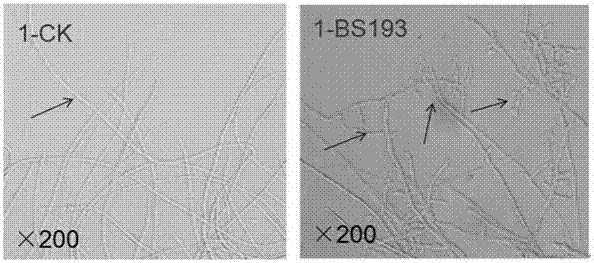Bacillus subtilis BS193 for preventing and controlling potato late blight and application of bacillus subtilis BS193
A technology of Bacillus subtilis and potato late blight, which is applied in the direction of application, bacteria, and fungicides, can solve the problems of unsatisfactory chemical control effects and environmental pollution, and achieve the prevention and control of potato late blight, reduction of agricultural pollution, and simple cultivation conditions Effect
- Summary
- Abstract
- Description
- Claims
- Application Information
AI Technical Summary
Problems solved by technology
Method used
Image
Examples
Embodiment 1
[0021] Embodiment one: the identification of bacterial strain BS193
[0022] 1. Source of the strain
[0023] Strain BS193 was isolated from healthy tomato leaves. After washing the tomato leaves with tap water and drying them, select an appropriate amount of leaf tissue, wash with distilled water three times, disinfect with 75% ethanol for 3 minutes, clear with sterile water for 3 times, treat with mercury chloride for 10-15 minutes, and then wash with sterile water 3 times. Add 10 mL of sterile water and sterilized quartz sand into a sterile mortar, grind it into a homogenous slurry, cover it and let it rest for 30 minutes, suck 50 μL of the supernatant with a pipette gun and spread it on the NA medium, and after 48 hours, Colonies were grown for purification and preservation.
[0024] , observation of morphological characteristics
[0025] Streak inoculate the strain BS193 in LB medium (10 g tryptone, 5 g yeast powder, 5 g sodium chloride and 15 g agar powder, add disti...
Embodiment 2
[0028] Example 2: Antagonistic assay of bacterial strain BS193
[0029] Using the flat plate confrontation culture method, the bacterial strain BS193 was tested for antagonism against P. infestans. First, the mycelium block of P. infestans was inserted in the center of the rye medium plate, and when the colony of P. The strain BS193 was connected to the week point, and the width of the inhibition zone of the strain BS193 against Phytophthora sojae was measured after culturing at 25°C for 15 days. The results of the screening test showed that the strain BS193 had a good antagonistic effect on Phytophthora infestans ( image 3 ).
Embodiment 3
[0030] Embodiment three: bacterial strain BS193 fermented liquid preventive effect test
[0031] BS193 strain fermentation broth (10 8 cfu / mL), centrifuge at 8000r / min for 20min, and collect the cell pellet and supernatant respectively. After the bacterial cell sedimentation is washed several times with sterile water, the bacterial cell suspension with the same volume as the original fermented bacterial liquid is prepared with sterile water. Potatoes were sown in nutrient pots filled with sterile soil, four plants per pot. The roots were irrigated with 20 mL of strain culture liquid, bacterial suspension, and sterile filtrate, and 24 h later inoculated with 10 mL of Phytophthora spore suspension (concentration of sporangia 1×10 4 / mL). Each treatment was repeated 3 times, and inoculated with P. infestans after treatment with clean water and LB medium as the control, and treated with moisture. The disease incidence was investigated 3 days after inoculation.
[0032] The di...
PUM
 Login to View More
Login to View More Abstract
Description
Claims
Application Information
 Login to View More
Login to View More - R&D
- Intellectual Property
- Life Sciences
- Materials
- Tech Scout
- Unparalleled Data Quality
- Higher Quality Content
- 60% Fewer Hallucinations
Browse by: Latest US Patents, China's latest patents, Technical Efficacy Thesaurus, Application Domain, Technology Topic, Popular Technical Reports.
© 2025 PatSnap. All rights reserved.Legal|Privacy policy|Modern Slavery Act Transparency Statement|Sitemap|About US| Contact US: help@patsnap.com



